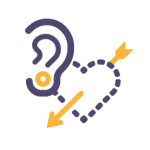3.4 Nonverbal Communication
Nonverbal communication is the process of conveying a message without the use of words. It can include gestures and facial expressions, tone of voice, timing, posture and where you stand as you communicate. It can help or hinder the clear understanding of your message, but it doesn’t reveal (and can even mask) what you are really thinking. Nonverbal communication is far from simple, and its complexity makes your study and your understanding a worthy but challenging goal.
Nonverbal communication involves the entire body, the space it occupies and dominates, the time it interacts, and not only what is not said, but how it is not said. Confused? Try to focus on just one element of nonverbal communication and it will soon get lost among all the other stimuli. Consider one element, facial expressions. What do they mean without the extra context of chin position, or eyebrows to flag interest or signal a threat? Nonverbal action flows almost seamlessly from one movement to the next, making it a challenge to interpret one element, or even a series of elements. How well can you correctly identify the feelings behind facial expressions?
Below are eight types of nonverbal communication:
- Space
- Time
- Physical characteristics
- Body movements
- Touch
- Paralanguage
- Artifacts
- Environment
Space
When we discuss space in a nonverbal context, we mean the space between objects and people. Space is often associated with social rank and is an important part of business communication. Who gets the corner office? Why is the head of the table important and who gets to sit there?
People from diverse cultures may have different normative space expectations. If you are from a large urban area, having people stand close to you may be normal. If you are from a rural area or a culture where people expect more space, someone may be standing “too close” for comfort and not know it.
Territory is related to control. As a way of establishing control over your own room, maybe you painted it your favourite colour, or put up posters that represent your interests or things you consider unique about yourself. Families or households often mark their space by putting up fences or walls around their houses. This sense of a right to control your space is implicit in territory. Territory means the space you claim as your own, are responsible for, or are willing to defend.
Among most humans there is a basic need for personal space, but the normative expectations for space vary greatly by culture. You may perceive that in your home people sleep one to each bed, but in many cultures people sleep two or more to a bed and it is considered normal. If you were to share that bed, you might feel uncomfortable, while someone raised with group sleeping norms might feel uncomfortable sleeping alone. From where you stand in an aerobics class in relation to others, to where you place your book bag in class, your personal expectations of space are often at variance with others.
Watch the following video: Personal Space – How Close is Too Close by CBS with special correspondent Taryn Winter Brill about personal space [2:55].
Video: Personal Space – How Close is Too Close by CBS with special correspondent Taryn Winter Brill about personal space [2:55] is licensed under the Standard YouTube License. Captions and transcripts are available on YouTube.
In the same way that there are cultural contexts and expectations for nonverbal behaviour, public speaking also happens in contexts. In North America, eye contact with the audience is expected. Big movements and gestures are not generally expected and can be distracting. The speaker occupies a space on the “stage,” even if it’s in front of the class. When you occupy that space, the audience will expect to behave in certain ways. If you talk to the screen behind you while displaying a PowerPoint presentation, the audience may perceive that you are not paying attention to them. Speakers are expected to pay attention to, and interact with, the audience, even if in the feedback is primarily nonverbal. Your movements should coordinate with the tone, rhythm, and content of your speech. Pacing back and forth, keeping your hands in your pockets, or crossing your arms may communicate nervousness, or even defensiveness, and detract from your message.
Time
Do you know what time it is? How aware you are of time varies by culture and normative expectations of adherence (or ignorance) of time. Some people, and the communities and cultures they represent, are very time-oriented.
When you give a presentation, does your audience have to wait for you? Time is a relevant factor of the communication process in your speech. The best way to show your audience respect is to honour the time expectation associated with your speech. Always try to stop speaking before the audience stops listening; if the audience perceives that you have “gone over time,” they will be less willing to listen. This in turn will have a negative impact on your ability to communicate your message.
Physical Characteristics
You didn’t choose your genes, your eye colour, the natural colour of your hair, or your height, but people spend millions every year trying to change their physical characteristics. You can get coloured contacts; dye your hair; and if you are shorter than you’d like to be, buy shoes to raise your stature a couple of inches. However, no matter how much you stoop to appear shorter, you won’t change your height until time and age gradually makes itself apparent. If you are tall, you might find the correct shoe size, pant length, or even the length of mattress a challenge, but there are rewards.
Regardless of your eye or hair colour, or even how tall you are, being comfortable with yourself is an important part of your presentation. Act naturally and consider aspects of your presentation you can control in order to maximize a positive image for the audience.
Body Movements
The study of body movements, called kinesics, is key to understanding nonverbal communication.
Body movements can complement the verbal message by reinforcing the main idea. For example, you may be providing an orientation presentation to a customer about a software program. As you say, “Click on this tab,” you may also initiate that action. Your verbal and nonverbal messages reinforce each other. You can also reinforce the message by repeating it. If you first say, “Click on the tab,” and then motion with your hand to the right, indicating that the customer should move the cursor arrow with the mouse to the tab, your repetition can help the listener understand the message.
In addition to repeating your message, body movements can also regulate conversations. Nodding your head to indicate that you are listening may encourage the customer to continue asking questions. Holding your hand up, palm out, may signal them to stop and provide a pause where you can start to answer.
Body movements also substitute or replace verbal messages. For example, if the customer makes a face of frustration while trying to use the software program, they may need assistance. If they push away from the computer and separate themselves physically from interacting with it, they may be extremely frustrated. Learning to gauge feelings and their intensity as expressed by customers takes time and patience, and your attention to them will improve your ability to facilitate positive interactions.
OK or Not OK?
Various motions and postures can mean altogether divergent things in different cultures. Hand gestures are a classic example. The American sign for OK means “zero” in Tunisia and southern France, which far from signalling approval, is considered a threat. The same gesture, by the way, delivers an obscenity in Brazil, Germany, Greece, and Russia. If you want to tell your British colleagues that victory on a new deal is close at hand by making the V sign with your fingers, be sure your palm is facing outward; otherwise you’ll be telling them where to stick it, and it’s unlikely to win you any new friends.
Eye contact is also an important bit of unspoken vocabulary. People in Western cultures are taught to look into the eyes of their listeners. Likewise, it’s a way the listener reciprocates interest. In contrast, in the East, looking into someone’s eyes may come off as disrespectful, since focusing directly on someone who is senior to you implies disrespect. So when you’re interacting with people from other cultures, be careful not to assume that a lack of eye contact means anything negative. There may be a cultural basis to their behaviour.
Touch
Before giving your presentation, you may interact with people by shaking hands and making casual conversation. This interaction can help establish trust before you take the stage. Once on stage, most people do not touch audience members physically, but you can interact with audience members through visual aids, note cards, and other objects.
Watch the following video: The Top 10 Bad Business Handshakes by BusinessGovAu [3:00]
Video: The Top 10 Bad Business Handshakes by BusinessGovAu [3:00] is licensed under the Standard YouTube License. Captions and transcripts are available on YouTube.
Kiss, Shake, Hug, or Bow
Additionally, touching is a tacit means of communication. In some cultures, shaking hands when greeting someone is a must. Where folks are big on contact, grown men might embrace each other in a giant bear hug, such as in Mexico or Russia.
Japan, by contrast, has traditionally favoured bowing, thus ensuring a hands-off approach. When men and women interact for business, this interaction can be further complicated. If you’re female interacting with a male, a kiss on the cheek may work in Latin America, but in an Arab country, you may not even get a handshake. It can be hard not to take it personally, but you shouldn’t. These interactions reflect centuries-old traditional cultural norms that will take time to evolve.
Paralanguage
Paralanguage is the exception to the definition of nonverbal communication. You may recall that nonverbal communication was defined as “not involving words” but paralanguage is a unique form of nonverbal communication that exists when we are speaking, using words. Paralanguage involves tone and nonverbal aspects of speech that influence meaning, including how loudly or softly you are speaking, intensity, pausing, and even silence.
Perhaps you’ve also heard of a pregnant pause, a silence between verbal messages that is full of meaning. The meaning itself may be hard to understand or decipher, but it is there nonetheless. For example, your coworker Jan comes back from a sales meeting speechless. You may ask if the meeting went all right. “Well, ahh…” may be the only response you get. The pause speaks volumes. Something happened, though you may not know what.
Silence or vocal pauses can communicate hesitation, indicate the need to gather thought, or serve as a sign of respect. Sometimes we learn just as much, or even more, from what a person does not say as what they do say.
Watch the following video: Paralanguage – It’s Not What You Say, It’s How You Say It by Janet Harliee [1:18].
Video: Paralanguage – It’s Not What You Say, It’s How You Say It by Janet Harliee [1:18] is licensed under the Standard YouTube License. Captions and transcripts are available on YouTube.
Artifacts
Do you cover your tattoos when you are at work? Do you know someone who does? Or perhaps you know someone who has a tattoo and does not need to cover it up on their job? Expectations vary a great deal, and body art or tattoos may still be controversial in the workplace. In your line of work, a tattoo might be an important visual aid, or it might detract from your effectiveness as a business communicator. Body piercings may express individuality, but you need to consider how they will be interpreted by employers and customers.
Artifacts are forms of decorative ornamentation that are chosen to represent self-concept. They can include rings and tattoos, but may also include brand names and logos. From clothes to cars, watches, briefcases, purses, and even eyeglasses, what we choose to surround ourselves with communicates something about our sense of self. Artifacts may project gender, role or position, class or status, personality, and group membership or affiliation. Paying attention to a customer’s artifacts can give you a sense of the self they want to communicate, and may allow you to more accurately adapt your message to meet their needs.
Watch this video: Inked @ UTSC by the University of Toronto Scarborough which Adon Irani shares the story behind his tattoos [1:24].
Video: Inked @ UTSC by the University of Toronto Scarborough [1:24] is licensed under the Standard YouTube License. Captions and transcripts are available on YouTube.
Environment
Environment involves the physical and psychological aspects of the communication context. More than the tables and chairs in an office, environment is an important part of the dynamic communication process. The perception of one’s environment influences one’s reaction to it. For example, Google is famous for its work environment, with spaces created for physical activity and even in-house food service around the clock. The expense is no doubt considerable, but Google’s actions speak volumes. In Google’s view, the results produced in the environment, designed to facilitate creativity, interaction, and collaboration, are worth the effort.
To summarize, nonverbal communication can be categorized into eight types: space, time, physical characteristics, body movements, touch, paralanguage, artifacts, and environment.
Communication for Business Professionals by eCampusOntario is licensed under a Creative Commons Attribution-ShareAlike 4.0 International License, except where otherwise noted.








